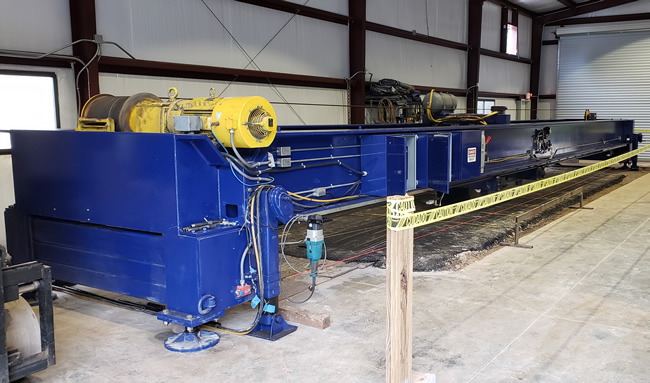Testing plays a vital role in the design and performance of transportation projects. Testing and monitoring improve infrastructure by providing valuable data before and after construction, allowing the designer and owner to better forecast system response and degradation. Accelerated pavement testing is one of the valuable tools that can be used to predict and validate performance, improve design methodologies, and support materials specification—all of which are factors in producing more reliable, more cost-efficient infrastructure.
ACCELERATED PAVEMENT TESTING
Accelerated pavement testing utilizes a full-scale testing environment and controlled loading from an accelerated pavement tester (APT) to simulate traffic on pavement test sections. Using an APT helps control the load, number of traffic passes, tire pressures, temperature, etc. for a more accurate and consistent assessment of road performance. Because it can work 24 hours per day, seven days per week, it can be used to evaluate systems in a matter of months rather than decades.
RELATED: Quantifying Pavement Damage in Overload Corridors
Full-scale testing may be part of a fixed device or an instrumented test track. APTs are also particularly well suited to evaluate the impact of heavier loads (e.g., truck axles) on pavement systems.

What are the limitations? As with all testing protocols, there are a few. Notably, the range of climate- and aging-related conditions that can be simulated in a single test is limited. Also, real-world conditions are often more diverse than can be simulated in a full-scale test. Related to that, the overall dynamic effect of truck loads moving across a roadway cannot absolutely be captured in a testing environment.
Still, this technology can be used to produce reliable, highly beneficial understanding of pavement system response and performance; and that is vital to achieving more cost-effective, longer-lasting, and safer transportation infrastructure.
APT INSTALLATION IN GREENVILLE
In 2018, TRI Environmental opened a new laboratory in Greenville, South Carolina. The company expanded from its outdoor, large-scale testing facility in nearby Anderson. With the new facility and nearly double the land on which to conduct large-scale research, TRI has added some interesting capabilities, one of which is a large APT.
The APT apparatus and other large-scale transportation testing is overseen by Eli Cuelho, P.E., who joined TRI in 2017 as the Director of Transportation Research, Testing and Services Division. Previously, he was part of the Western Transportation Institute at Montana State University.
The APT can apply a rolling wheel load up to 30 kips across a 36-ft.-long test bed. The APT is located in an indoor facility that has a concrete-lined trench 4 ft. deep by 11 ft. wide, used to construct an unlimited number of test sections and full-scale simulations.
Wheel loads are applied through a dual-wheel assembly equipped with tires rated for high-load carrying capacity. Application of the load is accomplished through two 12-inch pneumatic cylinders that react against a stiff frame. The wheel carriage assembly is pulled back and forth across the test area using a cable and winch assembly. Trafficking over the test sections is applied at speeds up to 8.8 ft/sec (6 mph).
Cuelho notes that the accelerated pavement testing apparatus height (and consequently the elevation of the applied load) is adjustable to accommodate a variety of sample heights and configurations. A wide assortment of instrumentation and data acquisition equipment is also available for monitoring purposes.
These options enable considerable test section customization for testing and monitoring a vast range of scenarios. Project owners, materials manufacturers (e.g., geogrid manufacturers), DOTs, and other stakeholders can use the technology to assess the impact of different types of vehicles (such as overloads), different types of tires and inflation pressures, load limits on unique pavements and foundations, etc.
For more information about TRI Environmental’s APT, cyclic plate load device, and other testing and research capabilities, visit www.tri-environmental.com.












